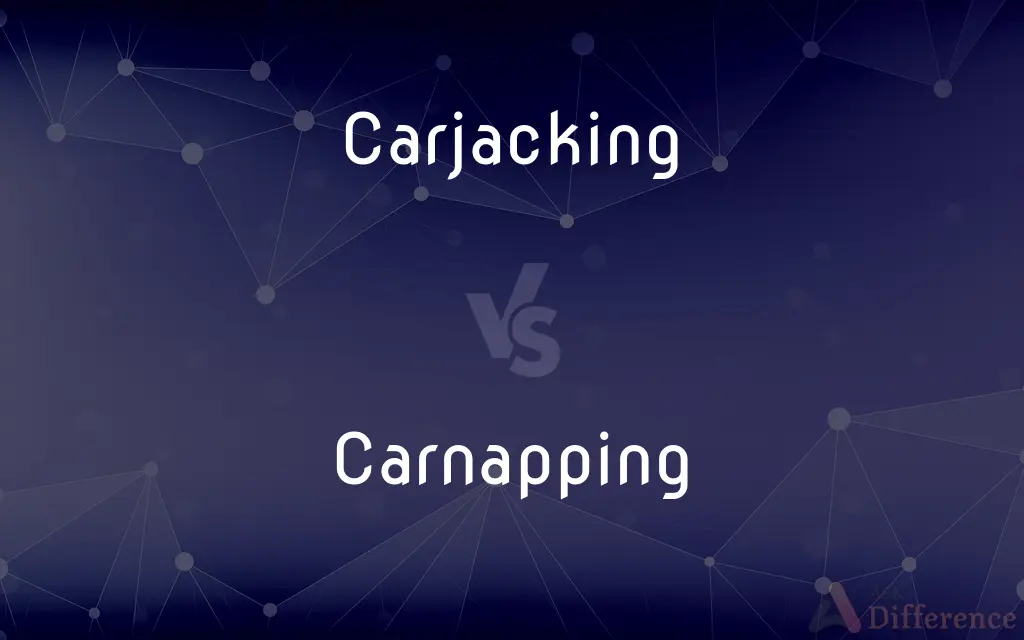Carjacking vs. Carnapping — What's the Difference?
By Urooj Arif & Fiza Rafique — Updated on March 5, 2024
Carjacking involves forcibly stealing a vehicle directly from its owner, often involving threats or violence, whereas carnapping refers to the theft of a vehicle in the owner's absence, focusing on the act of stealing cars without direct confrontation.

Difference Between Carjacking and Carnapping
Table of Contents
ADVERTISEMENT
Key Differences
Carjacking is a crime that directly involves the vehicle's owner or operator, where the perpetrator uses force or intimidation to steal the vehicle. This act is immediate, confrontational, and often violent, with the thief demanding the keys or forcibly removing the driver from the vehicle. On the other hand, carnapping involves the theft of a vehicle without direct interaction with the owner. This term is used to describe the act of stealing parked cars, often involving breaking into the vehicle and hot-wiring it, or using other methods to bypass the vehicle's security systems without the owner's presence.
While carjacking poses immediate physical danger to the vehicle's owner or occupants due to the violent or threatening nature of the crime, carnapping is characterized by its stealthy approach, focusing on the absence of the owner. Carjacking incidents are typically more traumatic for the victim, given the direct confrontation and potential for physical harm, whereas carnapping victims discover the crime after the fact, experiencing loss and violation of property without the direct threat to personal safety.
The legal ramifications for carjacking are often more severe than for carnapping due to the violent elements involved in forcibly taking possession of the vehicle from someone. Prosecutors may charge carjacking as a felony with heavy penalties, reflecting the seriousness of the crime. Conversely, carnapping, while still a serious offense, may incur slightly lesser penalties in comparison, focusing on the theft of property rather than the violent means by which it was obtained.
Both carjacking and carnapping are significant concerns for law enforcement and vehicle owners alike. Preventative measures for carjacking often include staying vigilant in high-risk areas and keeping car doors locked even while inside the vehicle. For carnapping, preventative strategies focus on vehicle security, such as alarm systems, steering wheel locks, and parking in secure, well-lit areas to deter thieves.
Carjacking requires the perpetrator to operate with a level of boldness and willingness to confront and overpower the vehicle's occupants. In contrast, carnapping typically involves a more calculated, surreptitious approach to avoid detection, with thieves often targeting unattended vehicles in vulnerable locations.
ADVERTISEMENT
Comparison Chart
Definition
Forcible theft of a vehicle from its owner
Theft of a vehicle in the owner's absence
Interaction
Direct confrontation with the owner
No direct interaction with the owner
Method
Force, intimidation, or violence
Stealth, breaking in, hot-wiring
Victim's Experience
Immediate, potentially traumatic
Discovered after the fact
Legal Consequences
Often more severe due to violence
Slightly lesser, focusing on theft
Preventative Measures
Vigilance, keeping doors locked
Vehicle security systems, parking in secure areas
Criminal Approach
Boldness, direct confrontation
Calculated, surreptitious approach
Compare with Definitions
Carjacking
A crime involving direct confrontation to obtain a vehicle.
She became a victim of carjacking outside the mall.
Carnapping
Stealing a parked vehicle without the owner's knowledge.
His car was carnapped overnight from his driveway.
Carjacking
Forcibly stealing a vehicle from the person in control.
The driver was threatened at gunpoint during the carjacking.
Carnapping
Theft of vehicles by bypassing security systems.
The thief carnapped the car using sophisticated tools.
Carjacking
Use of violence or threat to steal cars.
Carjackings in the city have increased, with criminals often armed.
Carnapping
Stealthy approach to vehicle theft.
Carnappers often operate in the dead of night, avoiding detection.
Carjacking
Demanding vehicle keys through intimidation.
The carjacker demanded the keys, threatening harm.
Carnapping
Non-confrontational vehicle theft.
Carnapping rates have soared, with thieves targeting unattended vehicles.
Carjacking
Present participle of carjack
Carnapping
Illegally taking a car without direct threat or violence.
The car was found abandoned after being carnapped.
Carjacking
Immediate theft of a vehicle with the owner present.
The carjacking occurred at the traffic light, causing widespread alarm.
Carnapping
Present participle of carnap
Carjacking
Carjacking is a robbery in which the item taken over is a motor vehicle. In contrast to car theft, carjacking is usually in the presence and knowledge of the victim.
Carnapping
(Philippines) Grand theft auto; the theft of a motor vehicle.
Carjacking
To take or attempt to take (a motor vehicle) from another person by use of force or intimidation.
Carjacking
The violent hijacking of a vehicle and sometimes its driver.
Carjacking
The forcible taking of a car while the driver is in it; the robber may force the driver out, force the driver to drive while under threat of harm, or be forced to relinquish the controls while also being forced to remain in the car. In the latter two cases, the act also constitutes a kidnapping.
Carjacking
The violent theft of an occupied car
Common Curiosities
What is carjacking?
Carjacking is the crime of stealing a car by force or threat of force, directly from the car's owner or operator.
What is carnapping?
Carnapping refers to the theft of a car without direct confrontation with the owner, typically when the car is unattended.
How does carjacking differ from carnapping?
Carjacking involves direct confrontation and often violence, while carnapping is done in the owner's absence, focusing on stealth.
Are the penalties for carjacking more severe than for carnapping?
Yes, due to the violent nature of carjacking, the legal penalties are typically more severe than those for carnapping.
Can carjacking happen in any location?
Carjacking can occur anywhere, but is more common in areas where drivers are more vulnerable, such as parking lots or traffic stops.
How can vehicle owners protect against carnapping?
Owners can use alarm systems, steering wheel locks, and park in secure, well-lit areas to deter carnappers.
Why is carjacking considered more traumatic than carnapping?
The direct confrontation and potential for physical harm in carjacking create a more immediate and personal trauma for the victim.
Is carnapping always non-violent?
While carnapping does not involve violence against the owner directly, it may involve breaking into and damaging the vehicle.
Can the public help in preventing these crimes?
Yes, public vigilance, reporting suspicious activities, and community cooperation with law enforcement can significantly help prevent these crimes.
What do thieves do with carnapped vehicles?
Carnapped vehicles may be stripped for parts, resold with falsified documents, or used to commit other crimes.
How do law enforcement agencies combat carjacking and carnapping?
Law enforcement combats these crimes with surveillance, undercover operations, and community awareness programs to educate the public.
How can one prevent carjacking?
Preventative measures include staying vigilant, keeping doors locked even when inside the car, and avoiding high-risk areas.
Does carjacking require a weapon?
Not always, but carjackers often use weapons or the threat of violence to intimidate the victim into surrendering their vehicle.
Can technology help prevent carnapping?
Yes, advancements in vehicle security technology, such as immobilizers and tracking systems, have helped reduce carnapping incidents.
What are common targets for carjackers?
Carjackers may target high-value vehicles, those in vulnerable locations, or situations where drivers are isolated or distracted.
Share Your Discovery

Previous Comparison
Vinasse vs. Molasses
Next Comparison
Brasswind vs. WoodwindAuthor Spotlight
Written by
Urooj ArifUrooj is a skilled content writer at Ask Difference, known for her exceptional ability to simplify complex topics into engaging and informative content. With a passion for research and a flair for clear, concise writing, she consistently delivers articles that resonate with our diverse audience.
Co-written by
Fiza RafiqueFiza Rafique is a skilled content writer at AskDifference.com, where she meticulously refines and enhances written pieces. Drawing from her vast editorial expertise, Fiza ensures clarity, accuracy, and precision in every article. Passionate about language, she continually seeks to elevate the quality of content for readers worldwide.
















































